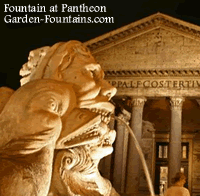 Instructions were given before the fountain was built, stating that need to be “well worked, cleaned and pumiced and properly finished so that when the officers [of the Congregation] want to have it polished this can be done without further pumicing of the fountain; but the polishing is to be done at the expense of the People [i.e. the City Council], with the admonition that there should be no knots or lumps nor any kind of mark". A similarity to the Piazza Navonna fountain exists in the fountain in front of the Pantheon with the four masks around the basin. There were eight masks ordered for the fountains in Piazza Navona. Only four masks were used on the southern fountain of the Piazza Navona. However, the masks located on the sides of the Pantheon fountain were clearly based on the models of the Piazza Navona.
Instructions were given before the fountain was built, stating that need to be “well worked, cleaned and pumiced and properly finished so that when the officers [of the Congregation] want to have it polished this can be done without further pumicing of the fountain; but the polishing is to be done at the expense of the People [i.e. the City Council], with the admonition that there should be no knots or lumps nor any kind of mark". A similarity to the Piazza Navonna fountain exists in the fountain in front of the Pantheon with the four masks around the basin. There were eight masks ordered for the fountains in Piazza Navona. Only four masks were used on the southern fountain of the Piazza Navona. However, the masks located on the sides of the Pantheon fountain were clearly based on the models of the Piazza Navona.
This is evidence that the four masks located on the Pantheon fountain were actually the four made for the fountain in the northern end of the Piazza Navona. It is impossible to suggest who carved the masks, as there were many, many sculptors who crafted masks like these. The inspiration for these masks however, did come from Michaleanglo, and Jacobo was having these masks created at the same time for the Palazzo dei Conservatori.
Jacoba della Porta did have a number of conversations about the fountains with trusted craftsmen that he registered with a notary. The contracts for the masks explained how the masks were to be made. The men trusted with crafting the masks were: Giacomo Siila Longhi, Simone Moschino, Taddeo Landini, and Giuseppe Bartoli from Carrara and Giovanni Antonio de Osis from San Gimignano. The first two men made two masks, while the final two only made one, so there are only 7 masks. There was also once a balustrade that surrounded the short flight of steps. Now there is just an arrangement of rocks with grass and snakes, four dolphins, two crests, two identical descriptions and an obelisk with star and cross. These details were thought to compete with Bernini’s “Four Rivers” Fountain. This fountain was moved from the little piazza in San Macuto, where it had most likely been since the 15th century. It was moved in the 18th century, in the fervor of restoration and embellishment.
The idea was that even though it was small and had little ornamentation, it deserved a better setting than its current home. The Vatican comes up with list of more suitable places for the fountain. There were many places mentioned, like using this fountain as the northern fountain in the Piazza Novanna, as well as in the Plazzetto Venezia, which would make the fountain today a traffic roundabout centerpiece. It was also suggested for it to be placed in the Piazza San Gregoro on Celian Hill as a funeral monument. However the pantheon was the chosen location and it was dragged and set over the fountain whose original appearance was undergoing a drastic transformation. The celebration of the finished fountain, by Pope Clement was great!
Back to page 1
